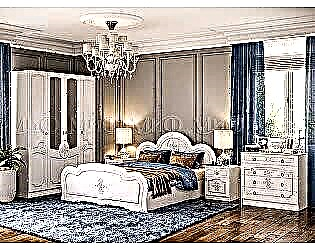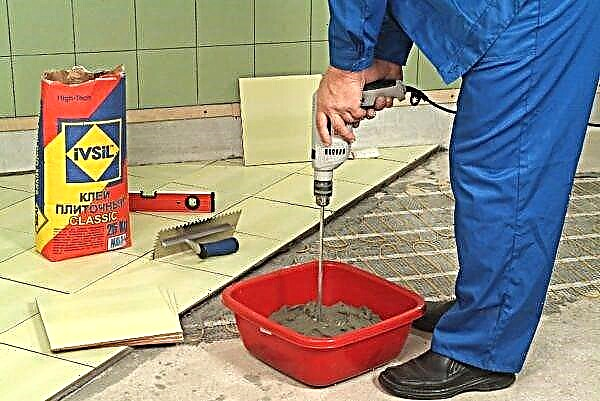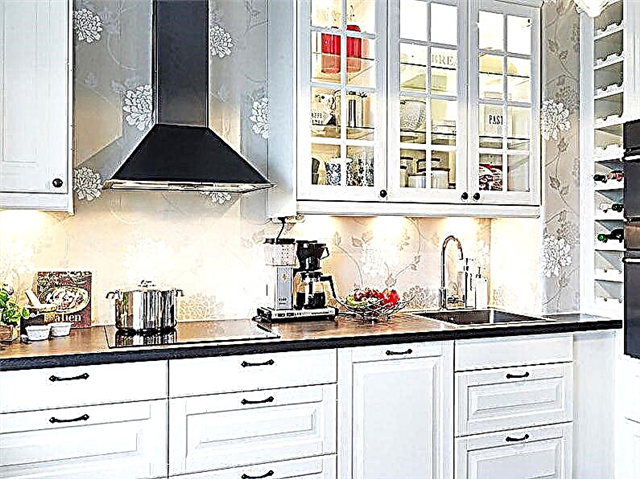Boring monotonous tiles are replaced with unique “paintings” or combined with exotic waterfalls, photographs, and elite murals. Such a picturesque and decorative work - the panel is designed to fill the sections between the wall cabinets and the countertop in the kitchen. "Highlight" is a barrier against food sediment, dirt, water spray and high temperature.
Kitchen wall decoration
The functionality of the work area also depends on the coverage. Tile is the target material to ensure this. Various finishes have determined the main criteria that you must rely on when buying.
Facing material requirements:
- Low porosity - in order not to absorb fat and soot. That is, the tile must have a uniform and dense structure.
- Protective coating against chemicals. It is designated by letters (it is specified in an order from the greatest resistance to the least): "AA", "A", "B", "C", "O".
- Resistant to abrasion and high strength. Indicators in this category are indicated by Roman numerals. For the kitchen is recommended - "REI-III."
On a wall apron, finishing material with a thickness of 4 cm is suitable.
Advantages and disadvantages
The following advantages are inherent in various types of tile:
- Strength. Subject to the correct laying technology, it is able to withstand multi-ton loads.
- Moisture resistance. The material practically does not absorb moisture.
- Wear resistance. The service life of tiles on the wall reaches 50 years.
- Fire resistance and environmental friendliness. The main component of the tile is clay. Therefore, the cladding elements do not ignite and do not emit harmful substances when heated.
- Ease of care. Clean contaminated coating with detergents.
- A variety of shapes and colors. The palette and sizes of "ceramics" are diverse: plain, with a pattern, ornament, wood, stone and other materials.
The disadvantages of the facing material include:
- Sophisticated styling technology. The tile “sticks” to a flat surface.
- Low thermal insulation. The material is cold, but when installing a warm floor under the tile is an excellent conductor.
The range of finishing materials is not limited to several variations. The following are distinguished:
- imitating stone, leather, wood, brick tile,
- tile with a metallized surface: styled in steel, copper, brass, gold, platinum,
- “Textile” tile - indistinguishable from canvas, tapestry, jute or other fabrics,
- volumetric ceramics: three-dimensional ornaments, faces or protrusions of various formats and styles,
- mosaic: usual, figured style (in the form of small circles or hexagons), glass (transparent with flowers, twigs or other decor inside),
The tabletop, made "under the stone", goes well with volumetric and textured tiles. And bright ceramics expand the space and give lightness.
- photo tile: any performance. The drawing is applied with special ink. Then the surface is coated with a special solution to maintain color. "Picture" is not scratched and does not require special care,
- hand-painted tile: abstract, floral, geometric patterns. The tile is styled with special paints for ceramics,
- floral motifs: various floral prints,
- tiles of contrasting colors with original patterns: a variety of colors in combination with psychedelic ornaments,
- panel from tiles: from mosaics (glued according to imagination), finished (drawing is already applied) and to order. Also distinguished by the "application" of the materials.
Glass
Glass has gained popularity in the design of the kitchen, due to easy cleaning (no seams) and ease of installation. The tempered glass apron looks bright and vibrant. It can be used not only for decorating walls, but also as a material for countertops. But there are other advantages:
- minimum care
- high strength material, higher than that of analogues (due to heat treatment),
- resistance to temperature extremes and mechanical damage,
- the use of various detergents to clean the surface,
- hygiene - excluded the growth of mold and fungus,
Acrylic and tempered glass materials are made. The drawing is transferred using photo printing, painting, fusing, filming or other techniques for applying. Therefore, design ideas have no limits. Such a “work” looks particularly impressive with backlighting in tone.
Ceramic tile
Ceramic panels are made in a wide variety of sizes, textures and shapes. Often the kitchen "highlight" is made out in addition with a special volumetric tile (friezes, borders). This allows you to create a "picture in a frame." Ornaments have different styles: rural landscapes, images of fruits, as well as floral, traditional and other ornaments.
Expert advice on how to furnish a kitchen in Khrushchev.
About the combined kitchen-living rooms will tell this article.
Decorative panel
Based on any selected picture, you can create a panel. "Pictures" are mainly made of mosaic and stucco type.
The decor in such cases is additional elements that differ from the background of the entire tile. Such a “highlight” is the pattern or color pattern. Read about the meaning as different feng shui symbols explain here.
Materials for decorative panels can be various types of ceramic plates. But they focus on the preparation of details (plates cut out a certain shape). If the "work" has a complex graphic or ornament, then you need a special apparatus for cutting ceramics.
Artistic decor element
The most difficult are the art panels. "Drawings" are painted directly on the tile. The ornament is characterized by complex shapes and strokes, so it cannot be glued from pieces of ceramics.
The "works" of this theme can be images of flowers, food or other patterns. But the main indicator is that the panel looks like a real picture.
If the panel does not fit the kitchen palette in the color palette, you can frame it in a border.
Video instruction how to make a tile for a decorative panel from plaster. It is not that difficult, try:
Apron for the kitchen
A simple way of decoration is pre-made ceramics. Among the many patterns, color and shapes distinguish the most popular:
- among the monotonous gamut of finishing materials - inserts of bright plates or the so-called "belt",
- brickwork of various color plates or plain to the middle of the wall,
- chaotic, convex patterns (two-, three-color),
- ordinary tile with ornament,
- a combination of tile shapes (among rectangular ones - square panels, a combination of different geometric shapes and colors),
- vertical application of components (lozenges),
- patterned masonry (slabs in combination, which result in an ornament),
- square tile.
If the kitchen is small, then use tiles of small sizes and shapes.
Features and Benefits
Sometimes a central position is occupied by a table, but this is provided that the room has a sufficient number of square meters. If the area is not so much, then you can make a highlight without spending it in vain. To do this, just make a panel of tiles.
The most common locations for kitchen murals or frescoes:
- Above the stove or cooking zone, directly under the hood.
- Around the sink where water is constantly running.
- In corners free of furniture.
- Above the fireplace.
- Near the dining table.
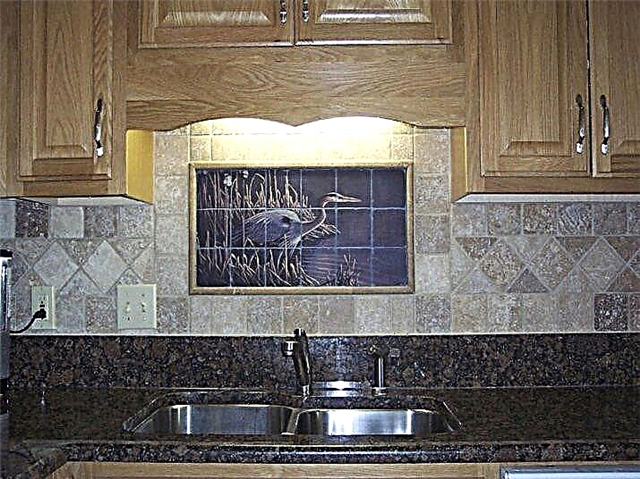
Such a ceramic decoration is not just elegant, there are quite reasonable functionally determined reasons for its use.
First of all, it is a heat and moisture resistant material that is not afraid of mechanical influences and sudden changes in temperature. Under the influence of steam, the wallpaper peels off, direct sunlight erases the pattern, the tree is rotten, plastic is often not easy to clean from stubborn greasy stains, and our alternative is practically for centuries.
Secondly, the material easily hides flaws. Not all Russian houses can boast of even walls. Sometimes, after the redevelopment, surprises remain from the previous owners: a shifted column, a battery, ventilation, or just holes from wall cabinets that used to fit into the interior. Ceramic squares and rectangles hide such nuances without much effort. No one will even guess what is hidden behind the skillful picture.
Thirdly, if you approach the matter wisely, then using a panel of tiles in the kitchen, the height is visually adjusted. Also, if you want to narrow / expand the area of the apron, the pattern will help you. A little visual illusion, and the effect will be just amazing.
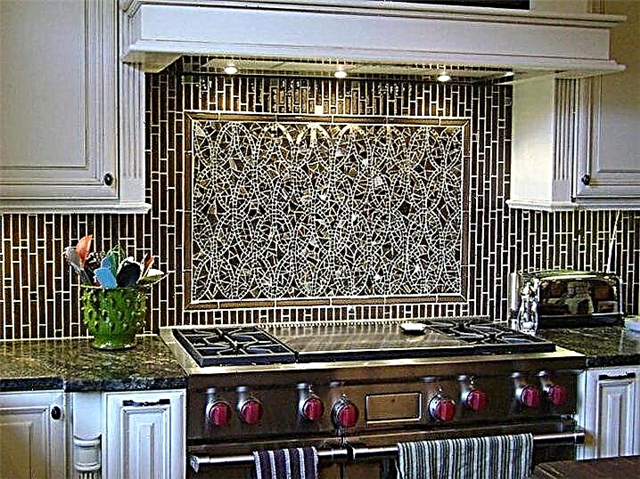
Consider specific examples and types of panels that can show off in your home:
Classic version - a panel with an image. The idea is simple. You have a certain composition, most often it becomes a central spot, and an auxiliary space (traditionally monophonic) is created around it. This is very unusual from an aesthetic point of view. Thanks to modern application mechanisms, a real masterpiece will appear in your kitchen.
Favorite motives are still lifes, gorgeous natural landscapes, sea views, hunting themes, wine and coffee line also quite in demand.

Mosaic. It can be a small tile (2-3 centimeters wide) and several colors or slightly larger samples (with a side of 10 centimeters), which in themselves are additionally distinguished by ornaments and look a bit like a patchwork quilt.
Such decisions are more common among lovers of the "modern" or "Provence" style.
Kitchen panel made from shards. The technique is painstaking, quite capricious in implementation, but very dramatic. The fragments resemble a broken mirror or a jug, and all together, put together, gives a feeling of luxury and coziness.
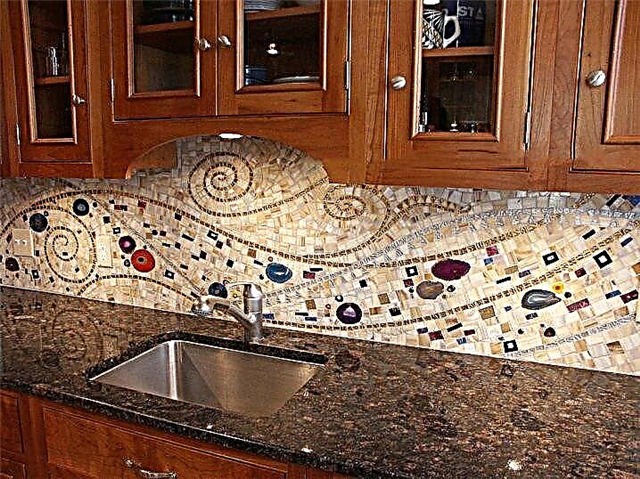
Hand-painted tile - This is another style of exquisite decoration. This option is similar to the first of the proposed ones, but the main difference is that the pattern will be unique. He will inspire you to prepare delicious dishes and gather the whole family, bringing incredible comfort and warmth to the house.

What secrets do you need to know in order not to get into trouble:
If you have chosen a finished panel with a certain pattern, and decided that it should be located on the apron, please note: the boundaries of the headset should coincide with the edges of the tile. Otherwise, the composition will look untidy, as if you got rid of some piece of furniture, although the entire repair was sharpened under the original set.
If you are not a fan of frequent cleaning and generally advocate that you spend as little time as possible on this task, choose smooth glossy or matte tiles. If it is embossed, then very soon fat and dirt will accumulate in it, which are not easy to clean.
Pay attention to shades and midtones. The panel should be combined with walls, floors and household appliances. Be careful if you do not want the room to resemble a rag doll sewn from different rags. Harmony in the ensemble is the key to your peace of mind.
If the kitchen is more of a cozy classic than a trendy hi-tech, then you try not just to decorate one of the zones with a picture, but use a technique like Arch (arch). With its help, you can create additional volumetric elements and the area near the stove will turn into something resembling a fireplace or a warehouse in an old cellar. Each time, preparing your dishes, you will feel like an insidious witch or a beautiful medieval maiden. Suitable for creative.
Tiles in different interiors
Panels are placed in areas requiring emphasis or visual highlighting. Therefore, "paintings" must be combined with the general background of the kitchen. But the tiles must be selected exclusively for the color of the furniture.
Especially well combines 10x10 tiles in the French or English interior. These are classic traditional styles, which are characterized by moderation, symmetry and the absence of catchy details.
The main colors are floral, vegetable, strip, cell, heraldry, and the palette is calm, not bright. According to these principles, they finish the working area or fireplace.
The predominant are aprons from pastel colors, curbs from intricate carvings (carved or with the effect of antiquity), and the panels are laid next to the stove and sink made of artificial stone among ordinary wallpapers. The plot of the "work" itself mainly depicts the landscape of the 18th century.
Key aspects in country are the neutral color palette and simplicity. Therefore, the tile is laid mainly monotonous, and the panel is depicted in a folk style (a rooster or a village is painted). Ceramic color - pastel light colors, without a pronounced decor. How to choose wallpaper for country style, read this link.
More modern styles in the design of the kitchen use wall glass, tiled or mosaic panels. The plot can be varied, but stylized under bright and catchy motifs. Read how to choose the right tile for an apron for the kitchen in the article.
The main factor in the design of a kitchen with a panel or apron is hygiene and surface protection. The palette, the combination of colors in the interior and the “zest” style can be different: glass, photo or ceramic. The main thing is to correctly combine the color scheme.
What is a panel
A ceramic panel is a decorative element of the interior made of many separate tiles, on which a part of the whole picture is applied. Sometimes the particles of the picture vary in size from the tile intended for the background. The image on the ceramic panel is a finished plot or a separate insert pattern.
Decorative panels made of tiles can become an aesthetic reference for a stylistic concept, since the options for the printed images are diverse: floral motifs, reproductions of paintings by great painters, national ornaments and photos of various designs.
Distinctive properties of ceramic panels:
- decorates the interior by combining with the "base" tile or as a separate composition,
- possesses heat resistance and moisture resistance,
- withstands mechanical stress and sudden temperature changes,
- long-lasting - lasts for decades,
- the material easily hides flaws - uneven walls, unsuccessful redevelopment,
- using a tile panel in the kitchen, the height is visually adjusted,
- the pattern in the apron area is able to visually narrow or expand this area.
A ceramic tile panel in the kitchen should be installed on one wall. If the area is limited, there are options where kitchen painting will be appropriate:
- in the area of the stove or hob, directly under the hood,
- around the sink, where water constantly falls,
- in corners, in the space free from furniture,
- Above the fireplace.
Please note: so that the tile panel on the kitchen for the apron looks exactly like a separate picture, it is not recommended to place it in the corner or back to back between the upper and lower cabinets. It is better to leave a free space at least half the height of the base tile.
reference. Ceramic panel visually changes the space even in a small room. In a small kitchen, it is recommended to place a composition of fine tiles.If you decorate the wall with large-format plates, this, of course, will attract attention, but also emphasize the modest size of the room. For rooms with large spaces, canvases made of large-format tiles are suitable.
Choose the plot of the panel in the kitchen
Ceramic composition should be in harmony with the surrounding interior and combined with the base tile.
When choosing a ceramic panel, be guided by a number of simple rules:
- the square shape of the tile is considered optimal, with its help it is easy to design the dimensions of the apron and position it relative to the kitchen surfaces more harmoniously,

- the amount of tile used depends on which laying method will be selected: vertical, horizontal or diagonal (with the latter, more is consumed);
- tiles with a smooth texture better give away pollution than a relief model,
- the color of the product must be in the same color scheme or combined with the surrounding furniture and walls,
- the original version is a panel of fragments of tiles, since it can appear as a central element of the decor of the kitchen, for example, in the form of volumetric drawings.
Images of kitchen panels for aprons are found in a wide range. The most familiar seem floral arrangements: bright poppies, delicate orchids, perky sunflowers.
However, there are other topics that are often used in the interior:
- landscape,
- still life,
- kitchenware,
- ornaments
- Tea and coffee theme
- wine,
- desserts.
In addition to the traditional decor, it is easy to choose panels with pictures of picturesque Mediterranean towns, abstract drawings, marine themes, graphics, reproductions of famous works or copies of ancient manuscripts and tapestries.
reference. If you are not afraid of experimentation, an interesting and bold decoration technique will be the combination of several plots in one interior. For example, birds of paradise and exotic flowers, bottles of wine and fruits, coffee and desserts. The main condition for successful combination is the observance of a single color scheme.
In addition to the standard versions of ceramic paintings, there are freeze-up models that do not have a certain size. The drawings depicted on the tiles do not have clear boundaries, so it is easy to independently complete a set of tiles, depending on the desired size.
Among the pluses of frisize tiles, their ability to increase the height of the ceiling or reduce the length of the wall due to a certain pattern, which somehow extends beyond the walls, is distinguished. Also, the plates create a smooth transition from a bright palette of panels to a neutral background cladding of the room.
Mosaic panel
Mosaic is a scattering of small ceramic or glass tiles ranging in size from 1 to 5 cm, called chips. For facing a kitchen apron most often use a mosaic with tiles of a format from 2 × 2 cm to 5 × 5 cm.
The recognition of the mosaic panel was due to the absence of design restrictions - the material is in harmony with such styles as Provence, loft, modern.
Another advantage of using ceramic mosaics is the visual increase in space. Also, a diverse color palette allows you to create volumetric drawings of various variations, for example, geometric ornaments, floral arrangements.
The material for the mosaic apron are glass, smalt, ceramics, marble. But the disadvantage of this “application” is a large number of seams. When applying mosaic aprons, glass grout for joints is required.
Hand painted panels
 The main distinguishing feature of the tile, the pattern that is made by the master manually is the uniqueness and uniqueness of the picture. The painting on such a tile cannot be washed off, it practically does not fade, but if this happens, then to a small extent and very soon.
The main distinguishing feature of the tile, the pattern that is made by the master manually is the uniqueness and uniqueness of the picture. The painting on such a tile cannot be washed off, it practically does not fade, but if this happens, then to a small extent and very soon.
Hand-painted panels are laid out using large tiles for the kitchen. The tiles on the kitchen panel are painted, after which they are burned and covered with glaze. As a result, the product is similar to that sold in stores.
Photoceramic panels
Photo printing technology is characterized by reliability and durability of the image. A “picture” is transferred onto the slabs, previously printed on decal paper using ceramic inks. After drying and long-term firing in a special oven for 10 hours, where the temperature reaches 900 degrees, a product called photoceramic tile is obtained. 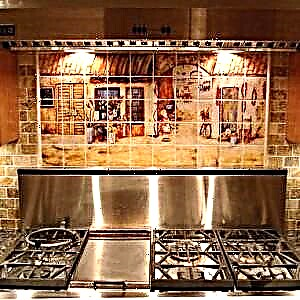
The main secret of technology in ceramic dye. This is a special paint that includes organic and inorganic compounds. During firing, organic components are burned, and inorganic dyes are melted into the upper layers of the tile surface. After that, the applied pattern and enamel surface form a single whole.
The process of obtaining photoceramics is a manual, painstaking, time-consuming work. At the same time, as a result of this process, tiles for the kitchen with a panel having a high-quality image are obtained.
Another option for applying an image to ceramics is sublimation. Its manufacturing technology is as follows: a polymer composition is applied to the tile, then a printed drawing. The printing method is relatively cheap, allowing you to apply an image of any format. Its main drawback is the short warranty period, about two years.
Stained glass panels
A stained glass window is a drawing made of glass mosaic. It happens in the form of picturesque images, ornaments and patterns, abstraction, silhouettes and contours. Most often, stained-glass windows in the kitchen are used in the manufacture of facade facades. 
The advantages of using glass patterns include their spectacular appearance and the ability to choose stained glass to any headset due to the variety of patterns and shapes.
Keep in mind that this option is difficult to maintain. On it constantly appear spots of fat during cooking and splashes of water after washing dishes. The proximity of the apron to the hob also has a negative effect. Exposure to high temperatures and aggressive detergents can ruin the surface, so it is better to make stained glass for the kitchen classic or sandblasted. It is better to refuse film and painted.
Decorative features of tiled paintings and panels
A ceramic tile panel in the kitchen should be installed on one or more walls, since this element performs aesthetic and utilitarian functions:
- gives the interior composition unique features,
- highlights the functional zones of space - the place of cooking and eating,





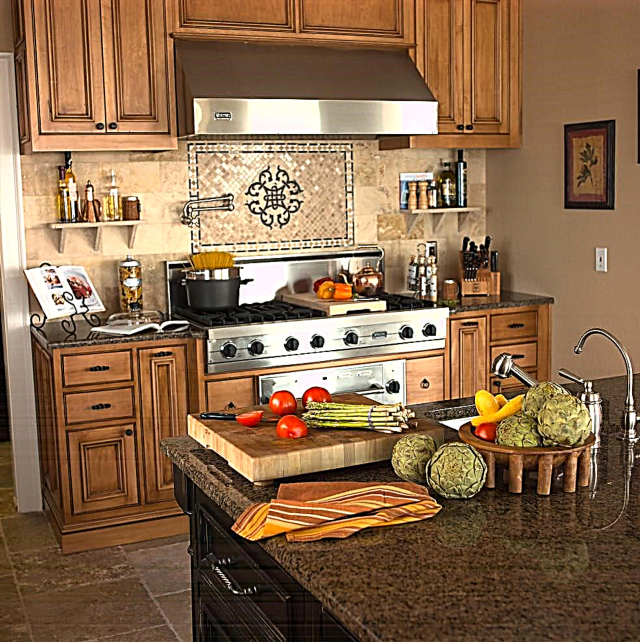
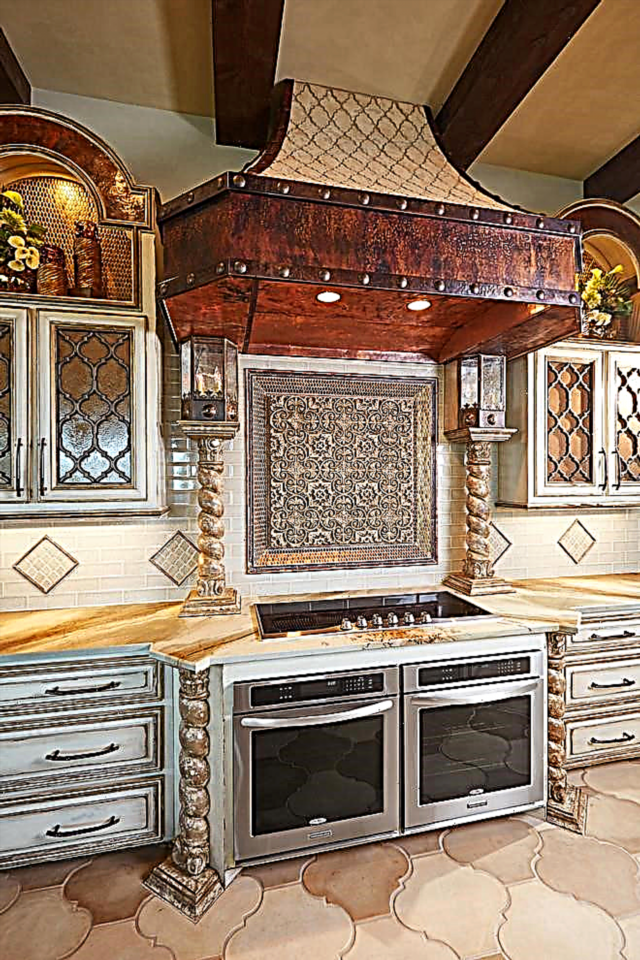
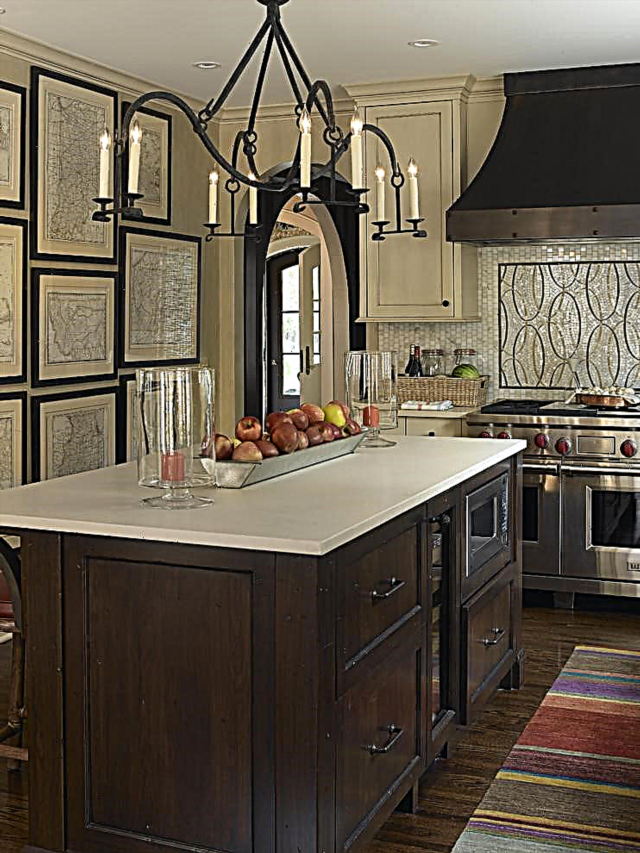



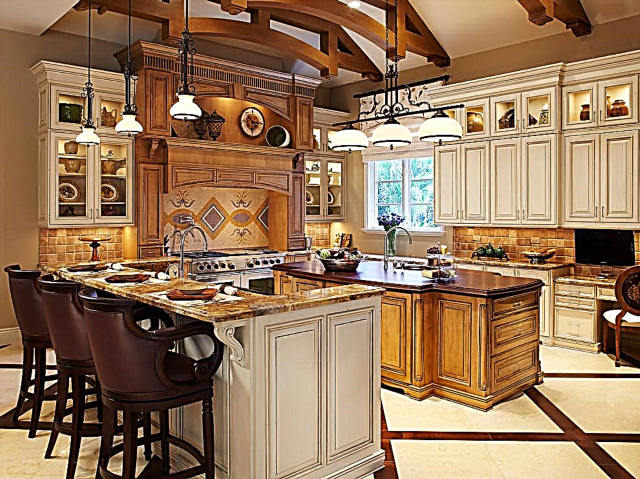
Decorative panels made of tiles for the kitchen can become an aesthetic landmark of the chosen stylistic concept, because they can be any floral motifs, reproductions of paintings by great painters, national ornaments and photos of various designs.
Idea! A tile with an illustration of a lavender meadow will silently indicate the dominance of the Provence style aesthetics in the house, models with drawings of modern city landscapes - the dominance of a loft or industrial style.
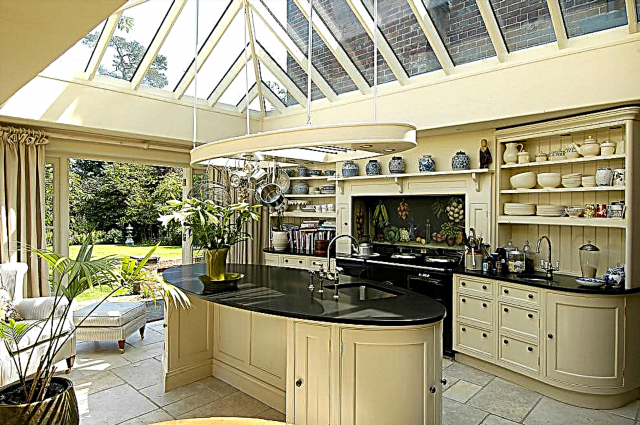
Stylish contrast: light beige kitchen and floral panel on a black background.
Often, the kitchen acts not only as a zone for cooking and organizing meals, but is also actively used for meetings with guests. Therefore, it is important to fill the room with interesting design elements that create an inviting atmosphere for relaxation and an inspirational setting for fruitful cooking.
The expressive wall decor from the illustrated tile can solve many design problems: set the style of the interior, act as a focal point that focuses on the graphic and color design of the tile panel, draw a clear line between the cooking area and the dining group. Therefore, you need to strictly determine the purpose of the picture from the tile and buy the best option, based on the design decision.



A panel of tiles in the kitchen on the apron: the selection of cladding and photo ideas
A bright decoration of the dining area can be a panel of photo tiles, mosaics or tiles, decorated manually by a skilled painter. It will become the main dominant in the picture of the interior of the kitchen, delighting others with its filigree design, non-trivial layout or original image.
On a note! This particular type of cladding belongs to the premium class, as it is handmade.
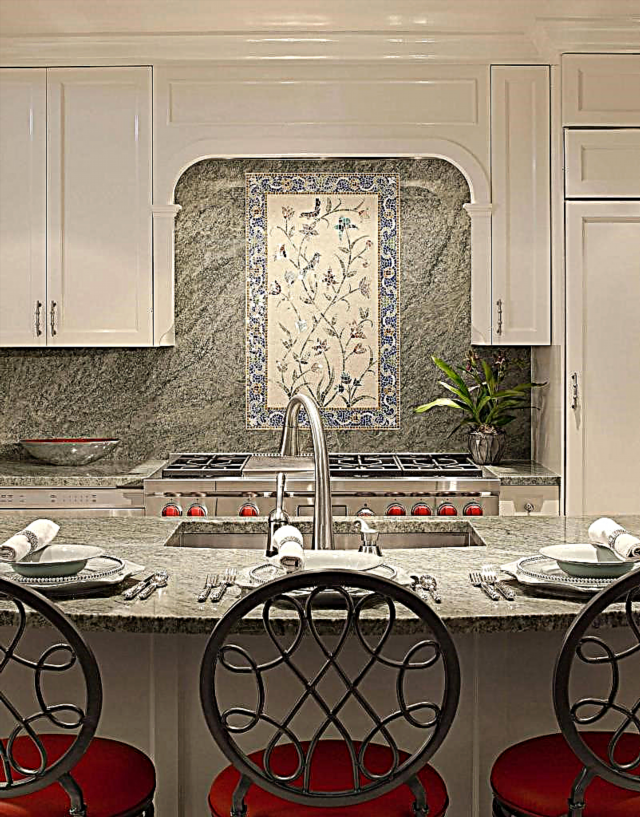
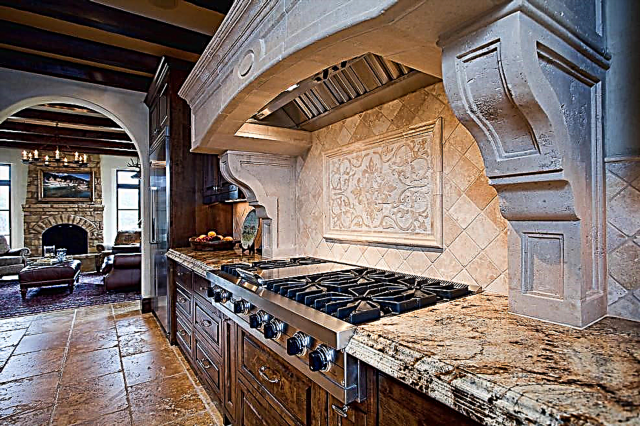

As a result of the painstaking work of builders and finishers, collecting ceramic paintings from mosaics, and skillful decorators to create unique panels, masterpieces of art decorating the walls of the house are born. A family portrait can be printed on them, a picture of a beloved artist or an abstraction transferred from the layout is depicted. On an individual order, manufacturers of tile panels can create a unique model with an individual design according to any provided picture.
Any image in high resolution can be transferred to the tile. Such printing is custom-made.
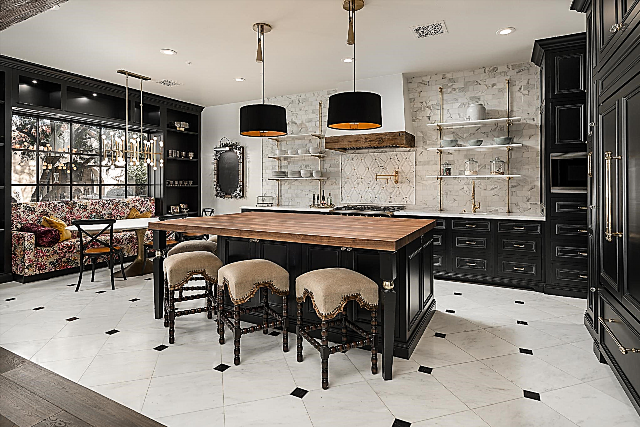
Beautiful spacious Mediterranean style kitchen
When designing a kitchen apron and a wall near the dining area, it is important to balance: ceramic paintings should complement each other or be two parts of the same plot.
For example, it is reasonable to decorate the wall above the cooking area of the panel with the image of coffee beans or tea leaves scattered in a chaotic manner, and place a picture from the mosaic above the dining table illustrating the table setting during coffee or tea drinking.

Harmonious wall decoration with picturesque tile panels will allow you to create a memorable interior composition that will not be found in any other kitchen space.
Advice! If for tiling a kitchen apron the choice of tile pattern is limited due to the small space on the wall between the floor and wall modules of the headset, then to decorate the dining area you can choose any form of panel in shape, size and design. Choose a model with an attractive format and decor that matches your individual aesthetic taste.
Traditional Mediterranean ornament on the background of terracotta tiles.
Tile panel properties and care
The expressive element of the wall cladding, due to its close proximity to the hob, sink and countertop, where it is customary to perform culinary tasks, must have excellent operational properties:
- high indicators of heat resistance, allowing not to lose their original appearance when heating the surface of the panel,
- an excellent degree of moisture resistance, since splashing water from a sink is inevitable when washing dishes,
- a high level of hygiene that counteracts the accumulation of fat and soot,
- Excellent wear resistance and compatibility with various cleaning products.
Mosaic garden landscape with birds
Superb fine mosaic kitchen apron
In order to preserve the perfect appearance of a tile pattern for a long time, you need to choose models that do not require delicate care. On the glazed and glass surface of the tile, traces of splashes of grease and water are more noticeable, unlike models with a matte finish. Therefore, in the cooking zone, the original design element should be protected as much as possible from the negative influence of the surrounding kitchen environment.
The choice of panels for the design of a kitchen apron
A kitchen apron is the most common place for placing a tile picture. To finish a fragment of the wall between the wall cabinets and the countertop of the kitchen unit, designers often use monophonic cladding that organically resonates in color or texture with the design of the rest of the room. A tile panel with flowers, a picturesque still life, a delicious dessert, glasses with sparkling wine or cups of steaming coffee will successfully dilute the monotony of the one-sided wall.
Fine mosaic on the wall to match the main color of the kitchen
Practical modern furnishings give greater freedom in choosing the plot and panel size
Ceramic tile is characterized by excellent strength, fire resistance and moisture resistance. The ceramic tile panel is ideal for decorating a kitchen apron. It is worth worrying about the seams between the parts of this trim element, which tend to darken due to the influence of moisture and the formation of mold.
To level the likelihood of darkening of the seams, it is necessary to use a moisture-resistant grout and a special protective varnish. At the junction of the kitchen apron with the countertop, you need to install a ceramic or plastic baseboard.
When designing a kitchen interior design, it is advisable to install a ceramic panel at the most remote distance from the hob or stove. With proper care and careful use of the panel of tiles can be used for a long time, while maintaining the appearance in its original state.
Advice! In the cooking zone, in order to preserve the impeccable appearance of the tiles, you need to choose a place on the wall, remote from sources of water and fire (sink and hob). Otherwise, you need to choose a monolithic panel without seams or made from rectified tiles.
Luxurious Art Nouveau kitchen with large mosaic panels
Interpretation of “Fruits” by Alfons Mucha is an eye-catching center for interior composition in the kitchen (see previous photo). This is an exclusive custom-made mosaic.
Choosing a Kitchen Design Style
The decor of the panel should correspond to the stylistic concept used for designing the interior design. Tile sets with the image of natural motifs are relevant to use for wall decoration in rooms with signs of the following interior genres:
An unusual version of the mosaic panel on the apron of modern kitchen
Why not choose an indie producer to decorate your kitchen like this? Pictured is a hand-painted Tiles by Mimi tile
Traditional white kitchen with an island in the center
On the tile panel, images of bridges, lighthouses, towers, houses and other architectural structures will become a characteristic feature of many design areas with urban motifs:
In order for the white tile panel to look dynamically on the kitchen apron, you need to choose a set of contrasting colors - with dark or bright facades. A snow-white tile with ornate patterns displaying the appearance of curly flowers and headsets with facades decorated with panels with a typical decor will echo among themselves. It’s important to choose a white panel from a tile to the kitchen for an apron for facing the room, made in the spirit of classic, provence and modern design directions.
Idea! Universal ceramic paintings on a light background are equally good in combination with whitewashed furniture typical of Provencal, vintage and classical aesthetics, as well as glossy headsets in black and catchy tones, found in kitchens with modern and hi-tech features.
Calm classic in pastel colors with a panel on the wall
It is advisable to use a catchy panel of tiles to the kitchen, decorated with bright colors, with the image of complex multi-colored ornaments, to decorate the space that characterizes the concept of pop art or boho. The ceramic painting will look spectacular in the dining area.
Unique author's design of the kitchen apron: a panel of fragments of tiles
Small mosaic panel with a stylized bright flower in a modern kitchen
To create a smooth transition from a bright panel palette to a neutral background cladding of the room, you need to frame it with a plain frieze.The wall panel in tandem with a floor mosaic rose will look magnificent in the dining area. Floor tiles in a round panel with an emblem or commander on horseback will create an aristocratic atmosphere in the dining room.
The interior composition with characteristic art objects is ideal for decorating spacious kitchens that embody the canons of historical design styles: Baroque, Art Deco, Rococo, Empire style and others.
Black and white furniture is complemented by an ornament above the hob
Country style in the interior of the kitchen
Interesting to know! Fans of the antique design style will appreciate the options with the image of mythological characters. Designers at Versace Fashion House recently released a collection of tile sets that featured a drawing of the head of the Medusa Gorgon.
Tile Set by Versace Tiles
Admirers of modern interior genres will probably decide to buy panels of ceramic tiles with various 3D-images. Pictures with a three-dimensional effect blur the line with the real world, allowing you to fully relax during dinner, admire the unusual panel of an apron made of tiles with a picture of the underwater world and suddenly mentally move to the bottom of the ocean.
Small eclectic kitchen in pale blue
Mosaic ornament over the sink area
Advice! Decorated tile can eloquently indicate the stylistic direction chosen for the design of the kitchen space. Therefore, you need to select models with tones, ornaments, patterns and drawings that are characteristic of a particular interior genre.
Mirrored panels
Mirror panels are considered environmentally friendly, moisture- and wear-resistant materials that can hide layout flaws and visually adjust the space.
There are many tricks to make the space of a small kitchen seem larger: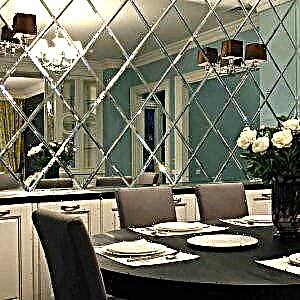
- a panel of mirrors along the entire wall visually changes the shape and size of the room - the kitchen looks rectangular if mirror tiles are placed on the wall opposite the main kitchen unit,
- placing a mirror panel opposite the window adds lighting to the kitchen,
- The alternation of mirror and ceramic tiles gives an interesting solution - this method creates the effect of a failure in the wall.
reference. Mirror apron - a modern and stylish solution for finishing the working area of the kitchen. This design creates a crushing effect and light overflows, an optical increase in space. As a finishing material use a mirror mosaic or tile.
Features of installing a tile panel in the kitchen
Before direct laying on the wall, lay the panel on the floor, so that it is convenient to make the necessary measurements. In case of discrepancy between the size of the composition and the space allotted to it, try to trim the edges so that you can achieve symmetry.
When laying, pay attention to the back of the tile, since the components of the overall picture are numbered there. There is an option to lay a tile with seams or apply a rectified type of tile - without seams. In order not to spoil the seams with a single composition, they are made within 1 mm. It is allowed to use a grout transparent, pick up to the main color or make contrast.
Attention! With a vertical arrangement of rectangles, the height of the apron visually increases, with a horizontal arrangement, it stretches in width.
Tiles are laid on tile glue, which has good viscosity and sets for a long time, so the first row often begins to shift. To prevent this from happening, a drywall profile or wooden rail is placed under the tile, temporarily screwing the structure to the wall.
Here are some styling recommendations:
- you cannot cut the panel,
- tiles with a relief are not laid in a corner, since adjacent elements will create gaps,
- it’s important that the pattern is centered on the main wall, with even clippings on the sides if necessary,
- it is better not to use a large number of bright paintings, so as not to overload the interior.
Also think about the possibility of using friezes and borders in the design of panels. They create a frame around the panel, giving it an even greater resemblance to the picture. The border also helps to harmonize between the panel and the base tile in color or texture.
Caring for a tile from a kitchen
To care for the ceramic panel was not burdensome, choose a matte tile. It better hides splashes, unlike the glazed and glass surfaces of tiles. In the cooking zone, the original design element should be protected as much as possible from the negative effects of the surrounding kitchen environment.
For cleaning a decorative ceramic painting, any detergents that do not contain abrasives are suitable.
Glass panels cannot be heated more than 80 degrees and create sharp temperature changes, otherwise the glass will deform.
Conclusion
A ceramic panel is always considered an original element of the kitchen interior, which not only distinguishes the functional areas of space, but also protects the walls from moisture, mechanical damage or high temperature.
With the right choice of the type of finishing material, the decorative picture models the space depending on the assigned design tasks - visually increases the height of the walls, reduces or expands the place where the apron is installed.


